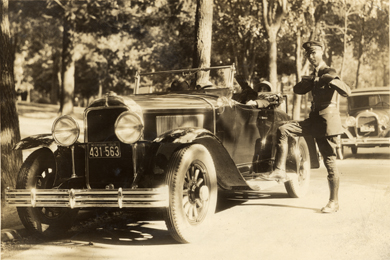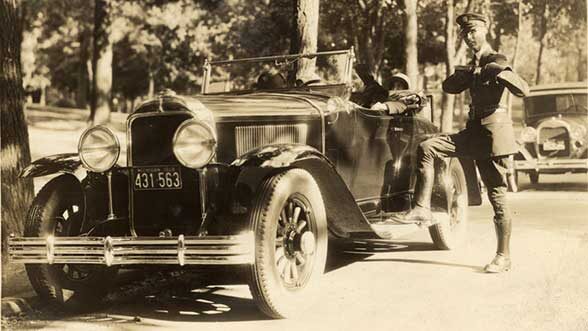It was not that he opposed the automobile on principle, U-M President Marion LeRoy Burton said. He knew it had become “an obvious necessity in modern life.” But in the midst of the great American car craze of the 1920s, the automobile at U-M was becoming not just an annoying distraction but a downright menace.

Chester Youngs was the police officer assigned to enforce the university’s rules on student driving. The skinny giant became well known to students, who nicknamed him “Andy Gump” after the tall and narrow comic-strip hero.
Detroit newspapers warned of “moral decay” in the back seats of student autos. Wealthy fraternity boys were seeing who could show off the latest and the biggest—not workaday Model Ts but big Stutz Bearcats and Cadillacs.
The new “Safety First” policy was a joke. An indignant alumnus told of stepping onto State Street just in time “to see a speeding car go shooting over the left-hand curb, smashing against a tree. The wind-shield goes to smithereens; the…driver drapes himself over the wheel; his…seat-mate goes out over the front door, and a fellow from the back seat takes his place in front, wrong side up. They all get themselves together, then laugh and shake hands. They do not learn a thing.”
President Burton’s successor, Clarence Cook Little, took office in 1925 determined to reinvigorate in loco parentis, the tradition by which college officials acted “in place of parents.” That year he tried a partial ban on autos; only upperclassmen in good academic standing could keep cars. But enforcement was ineffective and the craziness continued. By one count the upperclassmen were worse offenders than freshmen and sophomores.
When Little got news of another fatal crash one night in May 1927—this one in the country near Saline—he’d had enough. Following recent precedents at Princeton and Illinois, and with the regents’ hearty approval, he slapped down a total ban: From the following fall until he said otherwise, “No student…shall operate any motor vehicle.”
Joseph Bursley, dean of students, was authorized to relax the rule only in “exceptional and extraordinary cases.” Uproar ensued. By the Michigan Daily’s estimate, 3,000 students bought roller skates and raced around the Diag for days in ear-splitting protest, the steel wheels hitting the pavement late into the night. (Little denied the noise kept him awake, and he said the rollicking skaters were bringing “a better spirit” to the campus.)
The Daily’s editors, who had generally backed Little’s policies, including the partial auto ban, now decried “paternalism” and said the administration was undermining students’ property rights.
In a letter to the Daily, a woman student signing herself “M.T.” said she was beating the ban by taking evening pleasure rides around town by bus. “That’s all right, M.T.,” the editors replied, “but did the bus driver try to park anywhere?”

Protests against the car ban included a days-long, ear-splitting roller-skating rally in the Diag. (Photo Courtesy U-M Bentley Historical Library.)
The administration was favored by simple student turnover. With the passage of just two years, few students remained who had enjoyed the motorized free-for-all of the pre-1927 era, and when fatal accidents among students fell to zero, no one could say the ban had no good effects. Bursley began to implement exceptions for key events like the big weekend dance called J-Hop. And by the early 1930s, the Great Depression curtailed the car craze among all but the wealthiest students.
Sources include the papers of the Vice President for Student Affairs at the Bentley Historical Library, the Michigan Daily, the Michigan Alumnus, and Kent Sagendorph, “Michigan: The Story of the University” (1948).




Dale Stoner - 1965
I have never favored practices which separate men from their pursuit of ladies by allowing law enforcement to engage in willful breaking of the law to cutoff or otherwise curtail or abridge the right of way of innocent intelligent persons.
Reply
Jianmin Yi - 2002 (LLM)
Dear Editor and Jams Bobin,
This is a great article. I read it through the end with great amusement. The situation before the ban of autos driven by students as described here is some what similar to that now occurring to university students driving cars = in China, for example, students killed passengers on the street, and cars are parked everywhere and anywhere – almost 85 years from 1924-25 when the chaos brought by student driving occurred in Ann Arbor. Student drivers in China nowadays also imitate their predecessors in the Ann Arbor 85 years ago by showing off luxury’s brand of autos, no longer Stutz Bearcats and Cadillac, but BMW and Mercedes Benz. Should universities in China also imposed a ban on student driving autos, were, the article seemed to provide an answer to the university presidents here: Ban, Ban, Ban…
I am seeking permission by your editor or the author of the article for me to translate it into article into Chinese and publish it on Chinese website? Off course I will cite source of the article by James Tobin, publish Michigan Daily on Feb 9, 2011
Jianmin Yi
Delphi Attorney
Shanghai, China
Reply
Doug Griffin - 1967
When I arrived on campus in the early 60’s, freshmen and sophmores were not allowed to have cars. I earned enough money working road construction the summer before my sophmore year to buy a 1956 Oldes 88 convertible, which I successfully kept hidden behind my rental house on South University.
Reply
john mccormick - 1964
Great article. After reading it, I blew up the news article and was very surprised to see my uncle\’s name as a violator (Robert E. Neis). He eventually married my dad\’s sister and produced two children. One of them, John Neis, and I have kept a friendship. I have visited with him over the last couple of years to play golf in his Invitational in Tucson area and he has visited us to watch some games in the Big House. He also has a UM degree and eventually moved to Az. where he established a law practice. I called him about the article and he remembers his father discussing the issue. John relates that his father was a car nut and he owned a Stutz Bearcat about the time he attended UM. John remembers his father saying how much trouble he he caused himself over the car issue. He \”plea bargained\” with the U and got a lesser violation reported in the article. John suspects he was given better treatment because was president of his engineering class and a straight A student. John obviously inherited his father\’s negotiating talents while practicing law in Tucson.
.
Reply